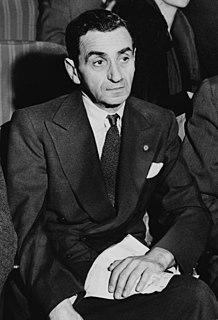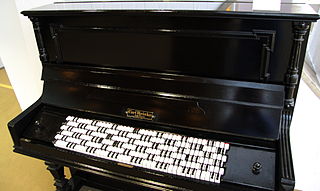Related Research Articles

The piano is a stringed keyboard instrument in which the strings are struck by wooden hammers that are coated with a softer material. It is played using a keyboard, which is a row of keys that the performer presses down or strikes with the fingers and thumbs of both hands to cause the hammers to strike the strings. It was invented in Italy by Bartolomeo Cristofori around the year 1700.

The recorder is a family of woodwind musical instruments in the group known as internal duct flutes: flutes with a whistle mouthpiece, also known as fipple flutes. A recorder can be distinguished from other duct flutes by the presence of a thumb-hole for the upper hand and seven finger-holes: three for the upper hand and four for the lower. It is the most prominent duct flute in the western classical tradition.

The tin whistle, commonly called the penny whistle, flageolet, English flageolet, Scottish penny whistle, tin flageolet, Irish whistle, Belfast Hornpipe, feadóg stáin and Clarke London Flageolet is a simple, six-holed woodwind instrument. It is a type of fipple flute, putting it in the same class as the recorder, Native American flute, and other woodwind instruments that meet such criteria. A tin whistle player is called a whistler. The tin whistle is closely associated with Celtic music.

Irving Berlin was a Russian American composer and lyricist, widely considered one of the greatest songwriters in history. His music forms a great part of the Great American Songbook.

A transposing instrument is a musical instrument for which music notation is not written at concert pitch. For example, playing a written middle C on a transposing instrument produces a pitch other than middle C; that sounding pitch identifies the interval of transposition when describing the instrument. Playing a written C on clarinet or soprano saxophone produces a concert B♭, so these are referred to as B♭ instruments. Providing transposed music for these instruments is a convention of musical notation. The instruments do not transpose the music; rather, their music is written at a transposed pitch. Where chords are indicated for improvisation they are also written in the appropriate transposed form.
In music theory, the key of a piece is the group of pitches, or scale, that forms the basis of a musical composition in classical, Western art, and Western pop music.

The Jankó keyboard is a musical keyboard layout for a piano designed by Paul von Jankó, a Hungarian pianist and engineer, in 1882. It was designed to overcome two limitations on the traditional piano keyboard: the large-scale geometry of the keys, and the fact that each scale has to be fingered differently. Instead of a single row, the Jankó keyboard has an array of keys consisting of two interleaved manuals with three touch-points for every key lever, making six rows of keys. Each vertical column of three keys is a semitone away from the neighboring ones, which are in the alternate rows. Thus within each row the interval from one note to the next is a whole step.

An electronic keyboard, portable keyboard, or digital keyboard is an electronic musical instrument, an electronic derivative of keyboard instruments. Electronic keyboards include synthesizers, digital pianos, stage pianos, electronic organs and digital audio workstations. In technical terms, an electronic keyboard is a synthesizer with a low-wattage power amplifier and small loudspeakers.

In music, sight-reading, also called a prima vista, is the practice of reading and performing of a piece in a music notation that the performer has not seen or learned before. Sight-singing is used to describe a singer who is sight-reading. Both activities require the musician to play or sing the notated rhythms and pitches.

The bass clarinet is a musical instrument of the clarinet family. Like the more common soprano B♭ clarinet, it is usually pitched in B♭, but it plays notes an octave below the soprano B♭ clarinet. Bass clarinets in other keys, notably C and A, also exist, but are very rare. Bass clarinets regularly perform in orchestras, wind ensembles and concert bands, and occasionally in marching bands, and play an occasional solo role in contemporary music and jazz in particular.

A fife is a small, high-pitched, transverse aerophone of Portuguese origin, that is similar to the piccolo. The fife originated in medieval Europe and is often used in Fife and Drum Corps, military units, and marching bands. Someone who plays the fife is called a fifer. The word fife comes from the German Pfeife, meaning pipe, which comes from the Latin word pipare.

Scientific pitch notation (SPN), also known as American standard pitch notation (ASPN) and international pitch notation (IPN), is a method of specifying musical pitch by combining a musical note name and a number identifying the pitch's octave.
The dulzaina or dolçaina is a Spanish double reed instrument in the oboe family. It has a conical shape and is the equivalent of the Breton bombarde. It is often replaced by an oboe or a double reeded clarinet as seen in Armenian and Ukrainian folk music.
In music, fingering, or on stringed instruments sometimes also called stopping, is the choice of which fingers and hand positions to use when playing certain musical instruments. Fingering typically changes throughout a piece; the challenge of choosing good fingering for a piece is to make the hand movements as comfortable as possible without changing hand position too often. A fingering can be the result of the working process of the composer, who puts it into the manuscript, an editor, who adds it into the printed score, or the performer, who puts his or her own fingering in the score or in performance.
Fingering...also stopping...(1) A system of symbols for the fingers of the hand used to associate specific notes with specific fingers....(2)Control of finger movements and position to achieve physiological efficiency, acoustical accuracy [frequency and amplitude] and musical articulation.

Generalized keyboards are musical keyboards, a type of isomorphic keyboard, with regular, tile-like arrangements usually with rectangular or hexagonal keys, and were developed for performing music in different tunings. They were introduced by Robert Bosanquet in the 1870s, and since the 1960s Erv Wilson has developed new methods of using and expanding them, proposing keyboard layouts including any scale made of a single generator within an "octave" of any size.

Finger substitution is a playing technique used on many different instruments, ranging from stringed instruments such as the violin and cello to keyboard instruments such as the piano and pipe organ. It involves replacing one finger which is depressing a string or key with another finger to facilitate the performance of a passage or create a desired tone or sound. The simplest type of finger substitution is when a finger replaces another finger during a rest; the more difficult type is to replace one finger with another while a note is being played.

The Stradella Bass System is a buttonboard layout equipped on the bass side of many accordions, which uses columns of buttons arranged in a circle of fifths; this places the principal major chords of a key in three adjacent columns.

The Wicki–Hayden note layout is a compact and logical musical keyboard layout designed for concertinas and bandoneons.
References
- ↑ Edwards, Owen (May 2008). "Ivory Merchant". Smithsonian Magazine : 40.
- ↑ Ng, David (October 8, 2010). "Irving Berlin piano spotlighted at National Museum of American Jewish History". Los Angeles Times . Retrieved January 21, 2022.
- ↑ Adams, Cecil (July 28, 2006). "If Irving Berlin couldn't read or write music, how did he compose?". The Straight Dope . Retrieved January 21, 2022.